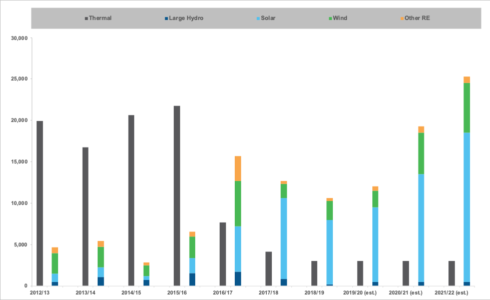Asia’s Green Power Opportunities: Who is Leading the Way?
25 March 2021 – by Eric Koons
What is green power and what types of opportunities are available in Asia? Green power is the production of energy using renewable resources with the highest environmental benefits, like:

- wind
- solar
- eligible biomass
- geothermal
- low-impact hydropower
Certain green power technologies are becoming cost competitive with conventional power sources. These cost trends, and the ability to harness renewable resources, has developers, policymakers and other investors seeking green power production opportunities. Throughout Asia, a wide variety of these opportunities have already been taken advantage of and many more are set to become available in the future.
India is Paving the Way for Green Power
In 2017, the Indian Government incentivized green power development. This created renewable energy prices that were 20-30 percent lower than coal-fired energy costs. By using “reverse auctions”, which enables renewable energy developers to view the bids made for projects, the Government created numerous advantages for all stakeholders. Developers maximized the use of available renewable resources, which increased competition and drove down electricity prices. Ultimately, this created an investment boom in renewable energy and legal/regulatory barriers were removed. This resulted in USD $40 billion of new investments, a doubling of renewable energy capacity, increased renewable energy targets and USD $500 billion in future investment opportunities.

Harnessing Geothermal Energy in Indonesia
By 2017, Indonesia had an installed geothermal power capacity of 1,800 megawatts out of an estimated potential of 29,000 megawatts – the largest in the world. The Indonesian Government is aiming to take advantage of their geothermal power potential by setting a 23 percent renewable energy target for 2025. To reach this target, approximately 7,000 megawatts of geothermal energy capacity will need to be developed. This is estimated to require an investment of USD $35 billion. To incentivize geothermal energy development, multiple loans have been provided by international organizations, like The World Bank. This reduces early stage exploration risk and incentivize large scale development of renewable energy. Moreover, if geothermal resources are easily accessed, its costs can become competitive with coal and natural gas energy technologies.

Green Power Opportunities in Vietnam
Vietnam has a variety of green power opportunities related to wind, low-cost solar and hydropower. It is considered to have the best wind resources in Southeast Asia, with a potential of approximately 311 gigawatts. Its solar PV potential is significantly greater with a potential capacity of approximately 2,847 gigawatts. And its hydropower has a potential of approximately 30-38 megawatts. However, to meet Vietnam’s future energy needs, it will need to install approximately 6-7 megawatts annually and invest USD $148 billion by 2030.
These examples highlight the wide variety of green power opportunities available throughout Asia. However, in addition to providing cost competitive power and significant investment opportunities, these technologies are associated with other benefits. These benefits are key pieces that should also be taken into consideration by stakeholders when evaluating the future returns of green power technology investments.

by Eric Koons
Eric is a passionate environmental advocate that believes renewable energy is a key piece in meeting the world’s growing energy demands. He received an environmental science degree from the University of California and has worked to promote environmentally and socially sustainable practices since. Eric’s expertise extends across the environmental field, yet he maintains a strong focus on renewable energy. His work has been featured by leading environmental organizations, such as World Resources Institute and Hitachi ABB Power Grids.
Read more

